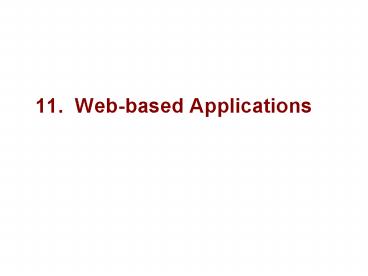11. Web-based Applications - PowerPoint PPT Presentation
1 / 24
Title:
11. Web-based Applications
Description:
Web-based apps offer many advantages: extend reach of application to ... http://host/page.asp. IIS. client. ASP. engine. HTML. 21. Visual Studio .NET. Example ... – PowerPoint PPT presentation
Number of Views:46
Avg rating:3.0/5.0
Title: 11. Web-based Applications
1
11. Web-based Applications
2
Objectives
- Real-world applications are typically
multi-tier, distributed designs involving many
components the web server being perhaps the
most important component in today's
applications... - Web-based applications
- IIS
- Static vs. dynamic web apps
3
Part 1
- Web-based applications
4
Web application
- Web server is just another tier
- Application now accessible over the internet
- from any client platform!
Web Server (IIS)
obj
obj
Web Page
Browser
obj
ANY platform
Windows Server
HTML / HTTP
Business
Data Access
Data
Presentation
5
Why?
- Web-based apps offer many advantages
- extend reach of application to people AND
platform - based on open, non-proprietary technologies
6
Types of web apps
- Two types
- WebForms GUI-based app displayed in browser via
HTML - WebServices object-based app returning raw XML
browser
HTML
Web server
Web Page
obj
obj
custom FE
SOAP,XML
obj
other App
7
Example workshop web site
8
Behind the scenes
Web server
Browser
Web Page
9
The key to web-based programming
- It's a client-server relationship
- client makes request
- server does some processing
- client sees OUTPUT of server-side processing
10
Part 2
- IIS
11
Internet Information Services (IIS)
- IIS is Microsoft's Web Server
- runs as a separate process "inetinfo.exe"
- requires a server-like OS Windows NT, 2000, XP
Pro, 2003 - multi-threaded to service thousands of requests
client
IIS
client
client
Windows Server
. . .
12
Configuring IIS
- Configured manually via
- control panel, admin tools, Internet Information
Services
13
A web site
- IIS deals with web sites
- A web site a web application
- How IIS works
- each web site has its own physical directory on
hard disk - each web site is assigned a virtual name for that
directory - users surf to web site based on virtual name
- Example
- web site lives in C\Inetpub\wwwroot\WebSite
- web site's virtual name is "AAAPainting"
- IIS maps virtual to physical
14
Creating a virtual directory
- When in doubt, right-click -)
- right-click on "Default Web Site", New, Virtual
Directory
15
Part 3
- Static vs. dynamic web sites
16
Types of web sites
- From IIS's perspective, 2 types
- static
- dynamic
17
Static web sites
- A static web site has the following
characteristics - all web pages are pre-created and sitting on hard
disk - web server returns pages without any processing
lttitlegtWelcome to AAA Paintinglt/titlegt lthtmlgt lth3
gtWelcome to AAA Paintinglt/h3gt ltHRgt ltolgt
ltligt ltA HREF"history.htm"gtHistory of our
companylt/Agt ltligt ltA HREF"prices.htm"gtPricinglt
/Agt ltligt ltA HREF"contact-info.htm"gtHow to
contact uslt/Agt lt/olgt ltHRgt lt/htmlgt
18
HTML
- Static web sites are typically pure HTML
- pages may also contain script code that runs on
client-side
lttitlegtWelcome to AAA Paintinglt/titlegt lthtmlgt lth3
gtWelcome to AAA Paintinglt/h3gt ltHRgt ltolgt
ltligt ltA HREF"history.htm"gtHistory of our
companylt/Agt ltligt ltA HREF"prices.htm"gtPricinglt
/Agt ltligt ltA HREF"contact-info.htm"gtHow to
contact uslt/Agt lt/olgt ltHRgt lt/htmlgt
19
Dynamic web sites
- A dynamic web site involves server-side
processing - How does IIS tell the difference?
- based on file extension of requested web page
- Example
- static request http//localhost/AAAPainting/defau
lt.htm - dynamic request http//localhost/Workshop/default
.asp
20
ASP
- Active Server Pages
- Microsoft's server-side programming technology
- ASP based on scripting languages, interpreted
- ASP.NET based on .NET languages, compiled,
faster,
IIS
http//host/page.asp
ASP engine
client
HTML
21
Example
- We want to dynamically create web page of
attendee's - i.e. generate the page by reading names from a
database
IIS
ASP Page
22
ASP page part 1, presentation
default.asp
- ASP page HTML code
lttitlegtRWWP.NET, July 2002lt/titlegt lthtmlgt lth3gtRWW
P.NET, July 2002lt/h3gt ltHRgt List of attendees
ltolgt lt Call OutputAttendees( )
gt lt/olgt ltHRgt lt/htmlgt ltSCRIPT
LANGUAGE"VBScript" RunAt"Server"gt Sub
OutputAttendees() . . .
inlinecodeblock
23
ASP page part 2, logic
Sub OutputAttendees() Dim dbConn, rs, sql,
firstName, lastName sql "Select From
Attendees" Set dbConn CreateObject("ADODB.C
onnection") Set rs CreateObject("ADODB.Reco
rdSet") dbConn.Open("ProviderMicrosoft.Jet.
OLEDB.4.0" _ "Data
SourceC\Inetpub\wwwroot\Workshop\Attendees.mdb")
rs.ActiveConnection dbConn rs.Source
sql rs.Open Do While Not rs.EOF
firstName rs("FirstName") lastName
rs("LastName") Response.Write("ltligt "
firstName " " lastName)
rs.MoveNext() Loop rs.Close
dbConn.Close End Sub lt/SCRIPTgt
24
Summary
- Web-based applications are commonplace
- Web-based applications are often mission-critical
- Two types
- WebForms form-based
- Web Services object-based































